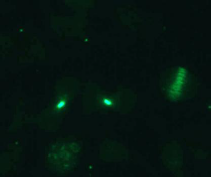| Background |
Borealin is a subunit of the chromosomal passenger complex (CPC), which is necessary for chromosome segregation and cytokinesis. While CPC shows a dynamic localization pattern during mitosis, Borealin and survivin, another subunit of CPC is essential to localize CPC at centromare from prophase to anaphase. It is thought that Borealin and survivin recruit aurora B, a kinase subunit of CPC, to inner centromare to allow phosphorylating appropriate substrates. |
| Note |
This product was originally produced by MBL International.
Protocol: SDS-PAGE & Western Blotting
1) Wash the 5x1026 cells 3 times with PBS and suspend with 500 µL of Laemmli’s sample buffer.
2) Boil the samples for 2 minutes and centrifuge. Load 5 µL of sample per lane on a 1-mm-thick SDS-polyacrylamide gel and carry out electrophoresis.
3) Blot the protein to a polyvinylidene difluoride (PVDF) membrane at 1 mA/cm2 for 1 hour in a semi-dry transfer system (Transfer Buffer: 25 mM Tris, 190 mM glycine, 20% MeOH). See the manufacturer's manual for precise transfer procedure.
4) To reduce nonspecific binding, soak the membrane in 5% skimmed milk (in PBS, pH 7.2) for 1 hour at room temperature, or overnight at 4oC.
5) Incubate the membrane with primary antibody diluted with PBS, pH 7.2 containing 1% BSA, 0.1% Tween-20 as suggested in the APPLICATIONS for 1 hour at room temperature. (The concentration of antibody will depend on the conditions.)
6) Wash the membrane with PBS-T [0.05% Tween-20 in PBS] (5 minutes x 3 times).
7) Incubate the membrane with the 1:10,000 HRP-conjugated anti-mouse IgG diluted with 1% BSA (in PBS, pH 7.2) for 1 hour at room temperature.
8) Wash the membrane with PBS-T (10 minutes x 3 times).
9) Wipe excess buffer on the membrane, then incubate it with appropriate chemiluminescence reagent for 1 minute.
10) Remove extra reagent from the membrane by dabbing with paper towel, and seal it in plastic wrap.
11) Expose to an X-ray film in a dark room for 2 minutes.
12) Develop the film as usual. The condition for exposure and development may vary.
(Positive control for Western blotting; 293T)
Immunoprecipitation
1) Wash the cells 3 times with PBS and suspend with 250 µL of cold Lysis buffer (10 mM Tris-HCl pH 7.4, 150 mM NaCl, 1% sodium deoxycholate, 1% NP-40, 0.1% SDS) containing appropriate protease inhibitors. Incubate it at 4oC with rotating for 30 minutes, then sonicate briefly (up to 10 seconds).
2) Centrifuge the tube at 12,000 x g for 10 minutes at 4oC and transfer the supernatant to another tube.
3) Add primary antibody as suggested in the APPLICATIONS into 50 µL of the supernatant. Mix well and incubate with gentle agitation for 30-120 minutes at 4oC.
4) Add 10 µL of 50% protein A agarose beads resuspended in the cold Lysis buffer. Mix well and incubate with gentle agitation for 60 minutes at 4oC.
5) Wash the beads 3-5 times with the cold Lysis buffer (centrifuge the tube at 2,500 x g for 10 seconds).
6) Resuspend the beads in 20 µL of Laemmli’s sample buffer, boil for 3-5 minutes, and centrifuge for 5 minutes. Use 10 µL/lane for the SDS-PAGE analysis. (See SDS-PAGE & Western blotting.)
(Positive control for Immunoprecipitation; 293T)
Immunocytochemistry
1) Culture the cells in the appropriate condition on a glass slide. (for example, spread 10e4 of cells per one well, then incubate in a CO2 incubator for one night.)
2) Fix the cells by immersing the slide in Acetone for 10 minutes on ice.
3) Prepare a wash container such as a 500 mL beaker with a magnetic stirrer. Then wash the cultured cells on the glass slide by soaking the slide with a plenty of PBS in the wash container for 5 minutes. Take care not to touch the cells. Repeat another washes once more.
4) Immerse the slide in PBS containing 0.1% Triton X-100 for 5 minutes at room temperature.
5) Wash the slide in a plenty of PBS as in the step 3).
6) Add the primary antibody diluted with PBS as suggested in the APPLICATIONS onto the cells and incubate for 1 hour at room temperature. (Optimization of antibody concentration or incubation condition are recommended if necessary.)
7) Wash the slide in a plenty of PBS as in the step 3).
8) Add 30 µL of 1:100 FITC conjugated anti-mouse IgG diluted with PBS onto the cells. Incubate for 1 hour at room temperature. Keep out light by aluminum foil.
9) Wash the slide in a plenty of PBS as in the step 3).
10) Wipe excess liquid from slide but take care not to touch the cells. Never leave the cells to dry. Promptly add mounting medium onto the slide, then put a cover slip on it.
(Positive control for Immunocytochemistry; HEp-2) |






























































































































































































































































 Germany
Germany
 Japan
Japan
 United Kingdom
United Kingdom
 China
China





